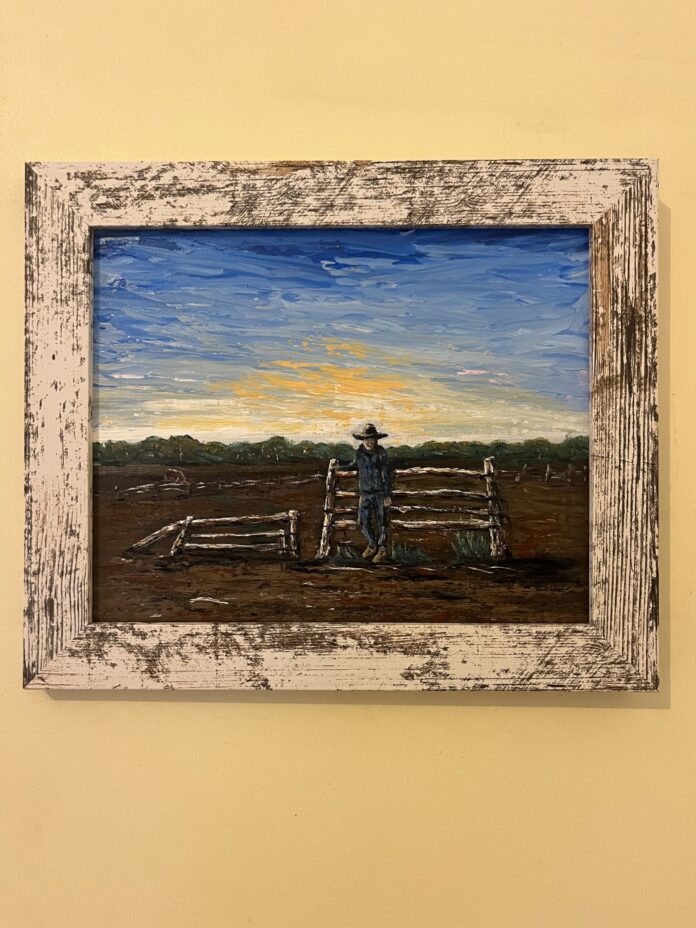Alexander Granich is an Australian-born artist whose life and work are deeply connected to the rugged landscapes and resilient people of the outback. Living and working in remote desert regions, Granich spent years in stock camps, mustering wild bush cattle, and experiencing firsthand the challenges and beauty of one of the harshest environments in the world.
His art reflects these experiences, infused with a raw honesty and emotional depth that comes from a life shaped by both resilience and hardship. Painting became his calling after a life-changing accident in 2019, transforming his personal struggles into a creative force that continues to inspire collectors and admirers around the world.
Carnegie Dreaming: A Commission of Honor
Among Granich’s significant works is Carnegie Dreaming, an oil painting commissioned by the Snell family. The piece is a tribute to Spencer Snell, a well-respected Australian stockman whose life was tragically altered by an agricultural accident.
Spencer’s story resonates deeply with Granich, not only because of their shared outback heritage but also because of the resilience required to face life-changing circumstances. Spencer was known for his hard work and dedication, living and working on one of the most remote cattle properties in the world. His accident left a lasting impact on his family, friends, and community.
Through Carnegie Dreaming, Granich captured more than a likeness he captured a spirit. The work serves as a testament to Spencer’s life and contribution, blending memory and dream in a way that immortalizes his connection to the land and to those who loved him.
From Stock Camps to the Studio
Granich’s ability to paint such profound tributes is rooted in his own life journey. Before devoting himself to art, he worked across remote stock camps, where days were spent mustering cattle under the blazing sun, nights were marked by solitude, and resilience was a way of life.
These experiences instilled in him not only a deep respect for the land but also an intimate understanding of the struggles faced by stockmen like Spencer Snell. When Granich suffered his own life-altering accident in 2019, he turned to painting as a way of coping, healing, and finding new meaning.
What began as an outlet for personal expression has since evolved into a flourishing career. Through his art, he channels both the vast beauty of the outback and the deeply human emotions of endurance, loss, and renewal.
A Unique Artistic Voice
Granich primarily paints in oils, embracing a loose, expressive style that captures the movement, atmosphere, and emotion of the landscapes he loves. His brushstrokes are bold yet sensitive, allowing the viewer to feel the vastness of the desert and the intensity of its colors.
While oils remain his primary medium, Granich has also achieved notable success in watercolor and ink, earning multiple awards that highlight his versatility as an artist. His works have been collected internationally, proving that although they are deeply Australian in subject matter, the themes of resilience and healing resonate universally.
For Granich, painting is less about technical perfection and more about emotional truth. “I just love to paint,” he says. “To be creative, to express myself, and to release pain and emotions through my artwork.”
The Healing Nature of Art
Art became Granich’s lifeline after his accident, offering him a way to transform pain into beauty. Every canvas became a place of release, where emotion could be expressed through color and form. This therapeutic quality is woven into all of his paintings, giving them a raw and authentic presence.
In landscapes, viewers can sense the solitude of the desert; in commissions like Carnegie Dreaming, they can feel the weight of memory and the resilience of the human spirit. His works invite not only admiration but also empathy, encouraging reflection on one’s own capacity to endure and to find meaning in hardship.
Recognition and International Reach
Despite the deeply personal nature of his work, Granich has achieved recognition well beyond Australia. Collectors from around the world have sought out his paintings, drawn to their emotional power and atmospheric quality. His awards in watercolor and ink demonstrate his technical skill, while his oil paintings remain the cornerstone of his artistic identity.
His reputation continues to grow as both an artist and a storyteller, someone who paints not just what he sees but also what he feels and has lived.
Conclusion
Alexander Granich’s journey from stockman to celebrated artist is a story of resilience, transformation, and creativity. His work, whether it is a sweeping desert landscape or a heartfelt commission like Carnegie Dreaming, captures the essence of the outback and the emotional truths of those who live within it.
Through his art, Granich honors stories of endurance and loss while celebrating the beauty of connection and survival. He reminds us that painting is not just about image but about emotion, about releasing pain, embracing resilience, and finding strength in creativity.
In every brushstroke, Alexander Granich tells the story of the outback and of the human spirit, proving that art has the power to heal, to connect, and to endure.


